A French croissant is a buttery, flaky roll named after its crescent shape. They are layered yeast breads that are folded with butter inside them.
I have been so excited ever since I joined this group created by Aparna of My Diverse Kitchen. I was one of the last few people who joined her late in the month of January. The first month’s bread (the pull-apart bread) was a real treat and we were very eager to find out what our next month’s project was going to be.

Never thought this month would be a chance to make one of my very favorite breads – The Classic French Croissants.
This was one of the things that I was very attracted to ever since I came to this country. Did I even attempt to try it by myself? Never, did not even think about it. When Aparna sent out the recipe for the French croissants, I was overwhelmed by emotions.
I so badly wanted to make it but was very intimidated by the long process and the precision this takes. Having said that, once I got my emotions in the handle and started making them, they came together very well. The recipe was not hard to make but was a three-day process and it requires a lot of patience and precision.

Let me introduce a little bit about French Croissants. A croissant is a buttery, flaky roll named after its crescent shape. They are layered yeast breads that are folded with butter inside them. This process is called laminating. Classic Croissants are a staple in French bakeries.
Aparna provided us with a very detailed recipe and picture guide to help us along. Will also include some links to watch at the end of my post, which I would highly recommend watching to anyone who is making this for the first time.
Also, the process of making Butter French Croissant requires a lot of rolling. So bring your strong arms and peaceful heart and get to work. The recipe she gave us is adapted from Jeffrey Hammelman’s at Fine Cooking.
This French Croissant is by far one of the hardest things that I have baked, but the end product is so delightful that I am ready to make it again. The Croissants have a lot of butter in them, but the indulgence is worth it.
I am attempting to give a detailed procedure with step-by-step pictures, but if you have any questions, please feel free to write to me. Also, the post is pretty long because I decided not to merge any pictures to help ease understanding of the process.
I love baking and have made many recipes, but by far this remains one of my favorite recipes that I have baked.

Ingredients to make French Croissants – Makes 16
To make the dough -
- All-purpose flour – 4 cups plus more for dusting and rolling the dough
- Warm water – ½ cup plus 2 tbsp
- Milk – ½ cup plus 2 tbsp
- Instant yeast or active dry yeast * (see notes) – 1 tablespoon plus 1 tsp
- Granulated sugar – ¼ cup
- Soft unsalted butter – 40 gms
- Salt – 2 tsp
*Notes – The original recipe used cold water and instant yeast. Just when I was getting ready to make the recipe, I realized that I did not have instant yeast. I had the active dry yeast. So I changed the recipe a little bit by dissolving the yeast in warm water to proof it and then added it to the flour when making the dough. If using instant yeast, you can add it as such to the dry ingredients and use cold water to make the dough.
To make the butter layer –
- Cold unsalted butter – 250 gms
- Egg wash or milk/cream – to brush the dough

Procedure to make French Croissants –
Day 1 –
Making the dough -
- If using instant yeast, combine all the ingredients in the bowl of an electric mixer, and with the hook attachment, start combining them on low. Scrape the sides and then again mix them at medium speed for about 3 minutes until the dough comes together.
- I used active dry yeast, so I proofed the yeast by adding it to ½ a cup of warm milk with about a teaspoon of sugar and letting it froth up for about 5 minutes. I added this mixture to the rest of the ingredients and proceeded the same way as mentioned above. Adding active dry yeast did not compromise the texture of the croissants, so go ahead and use what is available in hand.
- Lightly flour a 10-inch pie pan or a dinner plate and place the ball of dough in this.
- Gently shape the ball into a flat ball. Do not make it into a tight ball since this will strengthen the gluten and we do not need it. Shaping it slightly into a flat ball makes rolling it out the next day a touch easier.
- Lightly flour the top of the dough wrap it well with plastic wrap and refrigerate overnight. Make sure you wrap it up well because you do not want the dough to dry out.

Day 2 –
Making the butter layer –
- Cut 2 pieces of parchment or wax paper about 10 inches in size. Cut the cold butter into slabs about ½ inch thick and place them next to each other on one of the parchment paper. Place it in such a way that it forms a 5 to 6-inch square. Now cover it with the other parchment paper.

- Using a rolling pin, start pounding the butter gently until they all combine and stick together. Pound the butter until it flattens out evenly into a square about 7 ½ inches.
- Trim the edges of the butter to form a neat square. Add the trimmed pieces on top of the butter and pound them gently to combine. Place this butter in the refrigerator until we are ready to use it.

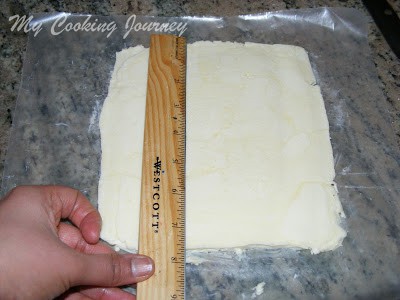
Laminating the dough –
- This is a fancy term to say that we are going to enclose the butter into the dough.
- Unwrap the dough and lay it on a lightly floured surface. Make sure that you leave a large area on the countertop to work with. Roll the dough into 10 ½ inch squares and brush off the excess flour.

- Now take the butter from the refrigerator. The butter should be cold yet pliable. If not, put it back in the refrigerator for some more time. This is to ensure that when rolling out the dough with the butter, it should not be too soft to leak out or too hard to break. Place the butter on the dough in such a way that it forms a diamond shape on the dough.

- Now close one of the flaps of the dough over the butter and stretch it lightly so it comes to the center. Now fold the opposite flap in the same way bring it to the center and over the previous flap and seal it.
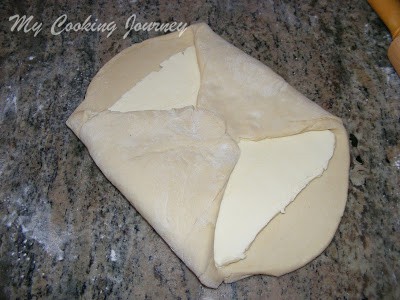
- Repeat the same process with the remaining two flaps and seal the edges well, so no butter is exposed out.

- Lightly flour the top and bottom of the dough and with the rolling pin firmly press it along the dough to elongate it. Focus on making the dough longer and not wider. Also, keep an eye on the edges to keep it as straight as possible.
- Roll the dough into an 8-by-24-inch rectangle. When rolling, if the edges lose their shape, use your hands to shape them slightly and then continue rolling.

- Now mark the dough in such a way as to divide it into 3 equal parts. Bring the top part towards the center and fold it one-third.

- Now fold the bottom one-third and bring it back over the already folded part. The dough is folded like a letter before going into an envelope.

- Place the folded dough in a floured baking tray and cover it with plastic wrap. Place this in the freezer for about 20 minutes to relax and chill the dough.

- After 20 mins, remove the dough from the freezer and place it in such a way that the open ends are facing you. Roll the dough lengthwise again forming a 8 by 24 inch rectangle and repeat the same folding process. Now leave this again in the freezer for 20 mins and then repeat the whole thing one more time.

- Now cover the dough with the plastic wrap after the third time and place it in the refrigerator overnight.
Day 3 –
Dividing the dough –
- Unwrap the dough and lightly flour the top and bottom. Cut the dough into 2 along the longer side. Cover and refrigerate one half when working with the other.

- Wake up the dough by pressing firmly along the sides of the dough. Focus again on lengthening it rather than making it wide. Slowly roll the dough into an 8 by 22-inch rectangle. The dough will start to shrink back during the process and will not want to lengthen. If this happens cover the dough and refrigerate for 10 mins and start rolling again.
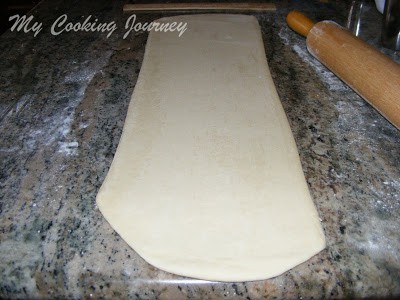
- Lift the dough every now and then let it shrink back a little and then roll. If the dough sticks, sprinkle some flour underneath and continue rolling.
- Now trim the edges straighten them and form a 20-inch long strip. Also, trim the sides to make it straight.
- Now we need to cut triangles from this rectangle. If you can eyeball them do so and cut them into 7 triangles. Or else, use a ruler to measure out and cut.
- With a knife mark the top of the dough at 5-inch intervals. You will have 3 marks and 4 parts.
- Now begin marking the bottom. Make a mark at 2 ½ inches from the end and then from here on mark at 5-inch space. You will have 4 marks that fall in between the marks on top.
- Make diagonal cuts using a ruler as a guide from the top point to the bottom pint. This way you will end up with 7 triangles and scrapes at each end.

Shaping the Classic French Croissants –
- Separate one piece of a triangle and start working with it. Using the rolling pin, slightly stretch the dough to make it about 10 inches long. Do not make it thin; just elongate it a little bit. This gives the croissants the layers and height.
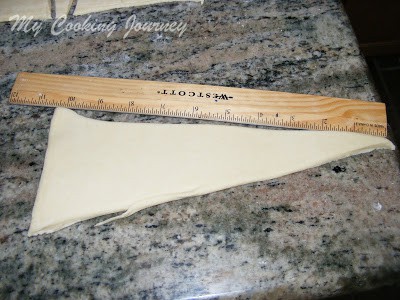
- Using a sharp knife make a small cut in the wider side of the triangle about ½ inch long. This cut helps to hold the crescent shape of the croissant.

- With the cut side near you start rolling the dough away from you. Roll the triangle tight but not too tight to compress it. Seal the pointy edge under the croissant.
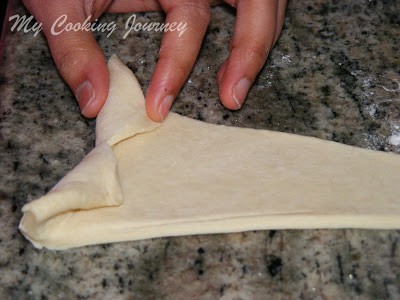


- Bend the two legs of the crescent shape together so that they touch each other. This will open up when proofing, but this helps to hold the shape better.

- Shape all the triangles in the same way and lay them on a parchment-lined baking tray leaving enough space between them. They do become a little bigger when baking.
Proofing the Classic French Croissants –
- Brush the croissants with egg wash or milk or a combination of milk and cream. If using an egg, whisk one egg with 1 teaspoon of water until smooth and brush this over each croissant. Refrigerate the remaining milk or egg wash to brush them again after proofing.

- Place the croissants in a cool draft-free place for about 1 ½ to 2 hrs. Sometimes it might need longer than 2 hrs. I proofed them for about 3 hours in my basement, which is much cooler than the rest of my house. Make sure you proof it in a cool spot. The butter should not melt during this time.
- The croissants will be distinctly larger but not exactly double the size after proofing. You could visibly see the layers of the dough when they were proofed enough.
Baking the Classic Croissants –
- Preheat the oven to 425 F. Brush the proofed croissants again with egg wash or milk and place the baking trays on top of the oven. I would recommend baking one tray at a time since the lower tray was getting brown at the bottom very soon. Bake for 15 – 20 mins or until nicely brown on top.

- Rotate the tray halfway through the process. Also, I had to lower the temperature to about 400 halfway into baking since I felt they were browning a little too quickly. It took me about 16 mins to get perfectly browned flaky croissants.

- Cool the croissants on the cooling rack and serve warm.



Notes and Observations -
I am also including the tips that Aparna mentioned in the procedure. I followed this and helped me achieve the best Classic Croissants I could possibly make.
- Ensure that your butter is cold – cold enough that it is pliable enough to smoothly roll out; not hard (or it will break) or soft (it will melt). If the butter is too hard and breaks while rolling out the dough, you will not get the layers in the croissants.
- Do not over-knead / develop the dough too much, too much gluten will not help during the lamination process. The lamination process itself is a kind of stretch and fold anyway and will strengthen the dough. So keep to the 3 minutes the recipe says. You want a soft dough, not an elastic one.
- When you cover the butter square with the dough, make sure you seal the dough well, otherwise, the butter will leak out when you roll out the dough, and there’s no way you can manage to put the butter back in. You will also end up with butter leaking during the baking.
- Always, always make sure your dough and butter inside it are cold. I cannot stress the importance of this enough. Once the butter has melted, it is difficult to get the dough to produce layers because the dough tends to absorb the butter and will make greasy croissants. So, while working with the dough, or when rolling it out, if at any point you feel the dough becoming warm and soft, put it back in the fridge immediately. Also, work as quickly as you can so the butter stays cold.
- During the lamination of the dough (rolling and folding repeatedly), chill the dough in the freezer and NOT the fridge. The overnight refrigeration is to be done in the fridge NOT in the freezer. Resting the dough is an important part of the croissant-making process.
- You also need a lot of patience to keep rolling out the dough with just enough pressure to stretch it. The rolled-out dough before shaping should be somewhere between ¼” and ⅛” thick.
- Make sure your dough is shaped with straight lines and square-ish corners. All the time you are rolling your dough out, keep this in mind. This way you will minimize the waste of dough. More importantly, the edges where there is no butter would get folded in during lamination and affect your layers. So trim off those bits if you have any of them.
- Keep lightly flouring your work surface (not too much), just enough to keep working smoothly without tearing the dough. However, dust with a light hand or you could end up adding more flour than desirable.
- Do not be tempted to fold more than three times. A fourth fold will give you more layers, but thinner butter layers between them, and your croissants will not puff off as much as you would like them to.
- And most important, as funny as it sounds. If you like to and do wear rings on your fingers like I do, take them off while working with this dough and the dough will thank you! Rings have a habit of inadvertently tearing the dough. If the butter comes out, patching it up by dusting a little flour can help but doesn’t always work.

More Breads
If you made this recipe and liked it, give a star rating on the recipe card or let me know in the comments below. You could also share it with me on Instagram using #MyCookingJourney and tagging me @sandhya.ramakrishnan. You could follow me and my recipes on Facebook |Instagram | Pinterest | Twitter/X
Recipe

Classic French Croissants | Flaky Butter Croissants
Ingredients
To make the dough -
- 4 cups All purpose flour
- ½ cup Warm water
- ½ cup Milk
- 1 tablespoon Instant yeast or active dry yeast see notes
- ¼ cup Granulated sugar
- 40 gms Soft unsalted butter
- 2 teaspoon Salt
To make the butter layer –
- 250 gms Cold unsalted butter
- Egg wash or milk/cream to brush the dough
Instructions
Day 1 –
Making the dough -
- If using instant yeast, combine all the ingredients in the bowl of electric mixer and with the hook attachment, start combining them on low. Scrape the sides and then again mix them at medium speed for about 3 mins until the dough comes together.
- I used active dry yeast, so I proofed the yeast by adding it to ½ a cup of warm milk with about a teaspoon of sugar and let it froth up for about 5 minutes. I added this mixture to the rest of the ingredients and proceeded the same way as mentioned above. Adding active dry yeast did not compromise the texture of the croissants, so go ahead and use what is available in hand.
- Lightly flour a 10 inch pie pan or a dinner plate and place the ball of dough in this.
- Gently shape the ball into a flat ball. Do not make it into a tight ball since this will strengthen the gluten and we do not need it. Shaping it slightly into a flat ball makes rolling it out the next day a touch easier.
- Lightly flour the top of the dough and wrap it well with plastic wrap and refrigerate overnight. Make sure you wrap it up well because you so not want the dough to dry out.
Day 2 –
Making the butter layer –
- Cut 2 pieces of parchment or wax paper about 10 inches in size. Cut the cold butter into slabs about ½ inch thick and place them next to each other on one of the parchment paper. Place it in such a way that it form a 5 to 6 inch square. Now cover it with the other parchment paper.
- Using a rolling pin, start pounding the butter gently until they all combine and stick together. Pound the butter until it flattens out evenly into a square about 7 ½ inches.
- Trim the edges of the butter to form a neat square. Add the trimmed pieces on the top of the butter and pound them gently to combine. Place this butter in the refrigerator until we are ready to use it.
Laminating the dough –
- This is a fancy term to say that we are going to enclose the butter into the dough.
- Unwrap the dough and lay it on a lightly floured surface. Make sure that you leave a large area in the counter top to work with. Roll the dough into 10 ½ inch square and brush off the excess flour.
- Now take the butter from the refrigerator. The butter should be cold yet pliable. If not, put it back in the refrigerator for some more time. This is to ensure that when rolling out the dough with the butter, it should not be too soft to leak out or too hard to break. Place the butter on the dough in such a way that it forms a diamond shape on the dough.
- Now close one of the flap of the dough over the butter and stretch it lightly so it comes to the center. Now fold the opposite flap in the same way and bring it to the center and over the previous flap and seal it.
- Repeat the same process with the remaining two flaps and seal the edges well, so no butter in expose out.
- Lightly flour the top and bottom of the dough and with the rolling pin firmly press it along the dough to elongate it. Focus on making the dough longer and not wider. Also keep an eye on the edges to keep it as straight as possible.
- Roll the dough to 8 by 24 inch rectangle. When rolling, if the edges lose their shape, use your hands to shape them slightly and then continue rolling.
- Now mark the dough in such a way to divide it into 3 equal parts. Bring the top part towards the center and fold it one third.
- Now fold the bottom one third and bring it back over the already folded part. The dough is folded like a letter before going into an envelope.
- Place the folded dough in a floured baking tray and cover it with plastic wrap. Place this in the freezer for about 20 mins to relax and chill the dough.
- After 20 mins, remove the dough from the freezer and place it in such a way that the open ends are facing you. Roll the dough lengthwise again forming a 8 by 24 inch rectangle and repeat the same folding process. Now leave this again in the freezer for 20 mins and then repeat the whole thing one more time.
- Now cover the dough with the plastic wrap after the third time and place it in the refrigerator overnight.
Day 3 –
Dividing the dough –
- Unwrap the dough and lightly flour the top and bottom. Cut the dough into 2 along the longer side. Cover and refrigerate one half when working with the other.
- Wake up the dough by pressing firmly along the sides of the dough. Focus again on lengthening it rather than making it wide. Slowly roll the dough into 8 by 22 inch rectangle. The dough will start to shrink back during the process and would not want to lengthen. If this happens cover the dough and refrigerate for 10 mins and start rolling again.
- Lift the dough every now and then and let it shrink back a little and then roll. If the dough sticks, sprinkle some flour underneath and continue rolling.
- Now trim the edges and straighten them and form a 20 inch long strip. Also trim the sides to make it straight.
- Now we need to cut triangles from this rectangle. If you can eye ball them do so and cut into 7 triangles. Or else, use a ruler to measure out and cut.
- With a knife mark the top of the dough at 5 inch intervals. You will have 3 marks and 4 parts.
- Now begin marking the bottom. Make a mark at 2 ½ inches from the end and then from here on mark at 5 inch space. You will have 4 marks that fall in between the marks on top.
- Make diagonal cuts using a ruler as a guide from the top point to the bottom pint. This way you will end up with 7 triangles and scrapes at each end.
Shaping the Classic Croissants –
- Separate one piece of triangle and start working with it. Using the rolling pin, slightly stretch the dough to make it about 10 inches long. Do not make it thin; just elongate it a little bit. This gives the croissants the layers and height.
- Using a sharp knife make a small cut in the wider side of the triangle about ½ inch long. This cut helps to hold the crescent shape of the croissant.
- With the cut side near you start rolling the dough away from you. Roll the triangle tight but not too tight to compress it. Seal the pointy edge under the croissant.
- Bend the two legs of the crescent shape together so that they tough each other. This will open up when proofing, but this helps to hold the shape better.
- Shape all the triangles in the same way and lay them on a parchment lined baking tray leaving enough space between them. They do become a little bigger when baking.
Proofing the Classic Croissants –
- Brush the croissants with egg wash or milk or combination of milk and cream. If using egg, whisk one egg with 1 teaspoon of water until smooth and brush this over each croissant. Refrigerate the remaining milk or egg wash to brush them again after proofing.
- Place the croissants in a cool draft free place for about 1 ½ to 2 hrs. Sometimes it might need longer than 2 hrs. I proofed them for about 3 hrs in my basement, which is much cooler than the rest of my house. Make sure you proof it in a cool spot. The butter should not melt during this time.
- The croissants will be distinctly larger but not exactly double the size after proofing. You could visibly see the layers of the dough when they are proofed enough.
Baking the Classic Croissants –
- Preheat the oven to 425 F. Brush the proofed croissants again with egg wash or milk and place the baking trays on the top of the oven. I would recommend baking one tray at a time, since the lower tray was getting brown at the bottom very soon. Bake for 15 – 20 mins or until nicely brown on top.
- Rotate the tray half way through the process. Also I had to lower the temperature to about 400 half way into baking since I felt they were browning a little too quickly. It took me about 16 mins to get perfectly browned flaky croissants.
- Cool the croissants on the cooling rack and serve warm.
Notes
Ensure that your butter is cold – cold enough that it is pliable enough to smoothly roll out; not hard (or it will break) or soft (it will melt). If the butter is too hard and breaks while rolling out the dough, you will not get the layers in the croissants.
Do not over-knead / develop the dough too much, too much gluten will not help during the lamination process. The lamination process itself is a kind of stretch and fold anyway and will strengthen the dough. So keep to the 3 minutes the recipe says. You want soft dough, not an elastic one.
When you cover the butter square with the dough, make sure you seal the dough well, otherwise the butter will leak out when you roll out the dough, and there’s no way you can manage to put the butter back in. You will also end up with butter leaking during the baking.
Always, always make sure your dough and butter inside it are cold. I cannot stress the importance of this enough. Once the butter has melted, it is difficult to get the dough to produce layers because the dough tends to absorb the butter and will make greasy croissants. So, while working with the dough, or when rolling it out, if at any point you feel the dough becoming warm and soft, put it back in the fridge immediately. Also work as quickly as you can so the butter stays cold.
During the lamination of the dough (rolling and folding repeatedly), chill the dough in the freezer and NOT the fridge. The overnight refrigeration is to be done in the fridge NOT in the freezer. Resting the dough is an important part of the croissant making process.
You also need a lot of patience to keep rolling out the dough with just enough pressure to stretch it. The rolled out dough before shaping should be somewhere between ¼” and ⅛” thick.
Make sure your dough is shaped with straight lines and square-ish corners. All the time you are rolling your dough out, keep this in mind. This way you will minimize waste of dough. More importantly, the edges where there is no butter would get folded in during lamination and affect your layers. So trim off those bits if you have any of them.
Keep lightly flouring your work surface (not too much), just enough to keep working smoothly without tearing the dough. However, dust with a light hand or you could end up adding more flour than desirable.
Do not be tempted to fold more than three times. A fourth fold will give you more layers, but thinner butter layers between them, and your croissants will not puff of as much as you would like them to.
And most important, as funny as it sounds. If you like to and do wear rings on your fingers like I do, take them off while working with this dough and the dough will thank you! Rings have a habit of inadvertently tearing the dough. If the butter comes out, patching it up by dusting a little flour can help but doesn’t always work.





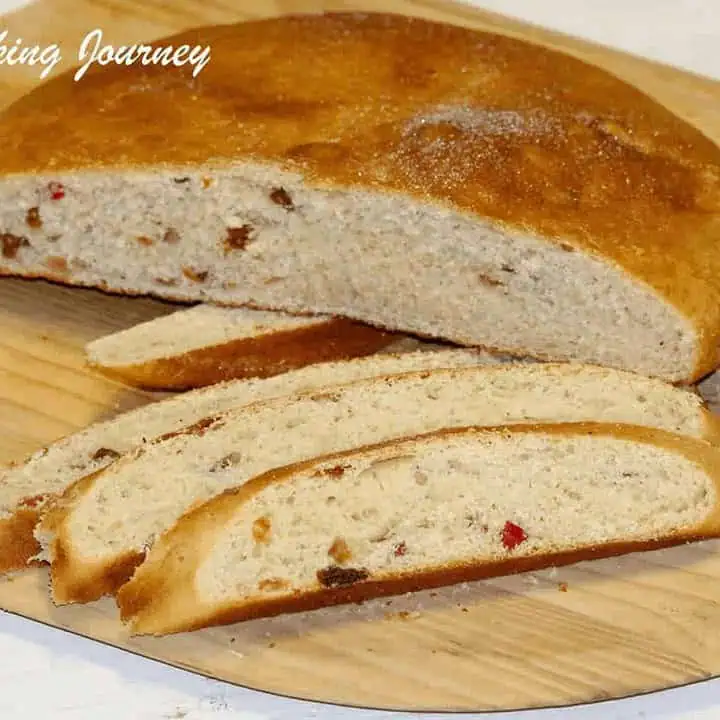
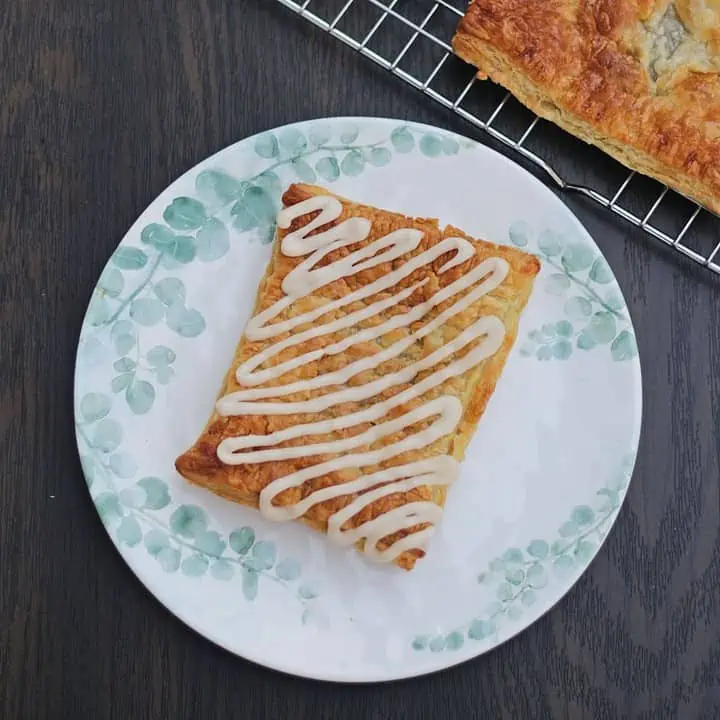



Holly says
These were fantastic and I'm so glad I finally made croissants. The recipe is well written, it's detailed to read through and I had to re-read it a few times to follow along correctly as I went, however that is necessary and next time it will be much easier. Yes I will definitely be making this recipe again. The croissants we all thought were as good as any we've bought, they were buttery and flaky but soft inside. Delicious. Thank you for this recipe. (I have photos to add but can't see an option to do this.)
Sandhya Ramakrishnan says
Holly, thank you so much for trying the recipe and letting me know. Croissants are time consuming but so rewarding. It does take a little bit of understanding for the initial couple of times, but then it does get easier. If you could share the pictures to me through email or any of the social media channel, that would be great.
Teena Mary says
wow...perfectly made croissants!! Bookmarked to give it a try 🙂
Archana Potdar says
Wow these are beautiful.
Rajani S says
I will echo what Jayanthi said - Perfect croissants... really!
Kavi Foodomania says
These look really very beautiful!! Loved your presentation too 🙂
Shanavi says
Looks flaky and wonderfully made..good that u've taken step wise pics..
Jayanthi says
Perfect! I can't seem to say another word after looking at your pictures. Very nicely presented.
Sona S says
delicious croissants..
Janani says
what a perfection love it.It looks very professionally made sandhya.Nice job.
Savitha says
Wow amazing post.My son's fav.Bookmarking it.
Jaleela says
wow amazing croissants
Lynne Daley says
Lovely croissants! A wonderful challenge!
Priya says
Omg, cant take my eyes from ur croissants,they were damn prefect and attractive, seriously loved ur stepwise pictures.
APARNARAJESHKUMAR says
ur pictures says everything 🙂 lovely demo !
Swathi Iyer says
Beautiful crossiant, you did very well.
Shailaja Reddy says
Looks perfect and tempting.
Meena Selvakumaran says
perfectly done.soft and yum.
WeR SAHM says
omg very delicious looking croissants...really appreciating u Sandhya ..... you made so perfect...
divya says
look absolutely tempting !! Gorgeous
Anonymous says
deivame 🙂 for some reason it smells like croissant when i see the pic, did u try some special photos ? awesome, and this one does not need eggs right ?-deepa
Gheza e shiriin says
WOw. Beautiful. would definitely give a try.bookmarked.
TC,
Humi
Ansh|Spiceroots says
Love the lovely hue on the croissants. They look perfect! Well done!
Aruna Manikandan says
looks perfect and very well explained 🙂
lata raja says
cute looking croissants and loved your pictures. they are calling out!
Reshmi Mahesh says
Beautiful and perfectly baked croissants...Nice detailed post..